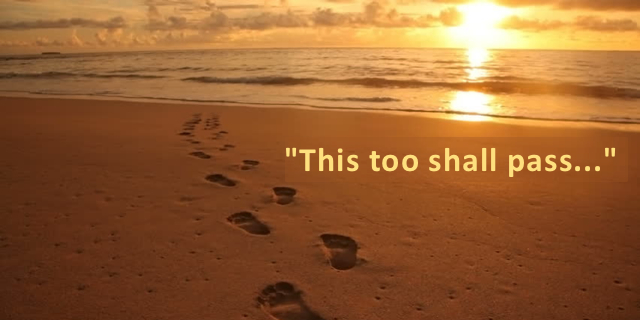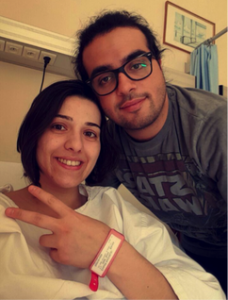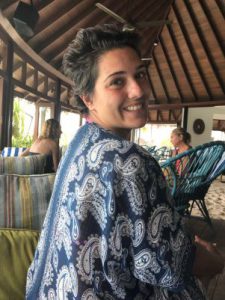“I am 24 years old. Last year on January 15th 2016, I was diagnosed with Stage 2A Classical
Nodular Sclerosing Hodgkin’s Lymphoma. I had 12 cycles of ABVD chemotherapy over 6 months and went into complete remission on August 8th, 2016.A few weeks before my wedding, on November 4th 2016 I had my first follow up CT scan which showed enlarged lymph nodes in my neck; a PET scan and biopsy later confirmed it: Relapsed Hodgkin’s Lymphoma.” ~Rachele Chaar Ghosn
In a personal email, Rachele stated, “I write from the heart and with my cancer experience as my current topic of interest, there is nothing that is more dear to me than conveying the many struggles that come with cancer to help anyone going through it who feels alone.”
Here is a post written for Medivizor where Rachele, a newly-wed, graduate student in microbiology, explains the struggle of treatment for relapsed Hodgkin’s Lymphoma: stem cell transplant.
By Rachele Chaar Ghosn, Author of My Second Fight Against Hodgkin’s Lymphoma
 People celebrate their birthdays once a year but from now on I will be celebrating twice. Once on my birthday and the other on March 16th. That is the day of my re-birth. The day I had my autologous stem cell transplant. This was the long awaited day; my second chance at a remission and at life.
People celebrate their birthdays once a year but from now on I will be celebrating twice. Once on my birthday and the other on March 16th. That is the day of my re-birth. The day I had my autologous stem cell transplant. This was the long awaited day; my second chance at a remission and at life.
Following the 3 ICE cycles [Ifosfamide, Carboplatin, Etoposide] that I had, I was admitted to the hospital to start the conditioning chemotherapy before the transplant. Once you’re admitted, the date and the days of the week no longer mark the days on your calendar. The countdown begins when chemo starts.
On Day -7, I started BEAM [high dose chemotherapy consisting of BiCNU ® – carmustine, Etoposide, Ara-C – cytarabine, Melphalan], which continued for 5 consecutive days. Day -1 was my day off and Day 0 was transplant day. Even though I already had a port-a-cath in my right chest, I was told that the central venous catheter is better to use because I will probably need a transfusion and saline at the same time at some point and since the catheter has 3 outlets it would be better to work with.
Stem Cells
I was expecting an uneventful process where they thaw and infuse my previously frozen stem cells back into my body through the central venous catheter that they inserted in the left side of my chest just below my shoulder. That did not happen.
I had a lot of nausea due to the DMSO, the chemical used to freeze the stem cells. It smelled a lot like garlic but that didn’t bother me. What made me nauseated was the burning feeling I got in my stomach; which I think was from the DMSO. I had a total of 5 bags of stem cells infused and I threw up right after the second one. All this was to be expected; though what wasn’t was the tachycardia (fast heart rate) and hot flashes. It is a very rare occurrence apparently but since I’ve been previously diagnosed with Supraventricular Tachycardia it wasn’t too shocking. It is a very uncomfortable procedure all in all, however the good news is all symptoms improve as you go along. So the worst were the first two bags and then the nausea almost entirely went away by the 3rd and the tachycardia was better maintained by the 4th. By the time we were done, I was back to normal.
Side Effects
Nausea
BEAM side effects started almost immediately after I was given the last chemo infusion (Melphalan). I

Caption by Rachele: “Few weeks into chemo. Sexy, right? Bald is my new look until my hair grows back again #baldisbeautiful”
started losing my appetite by Day -2, but by Day 0 I was already down to eating just one meal a day. When the nausea hit on Day +2 whatever was left of my appetite was gone. However, the doctors and nurses were wonderful. I was given Zofran and Primperan every 6 hours around the clock but unfortunately that wasn’t enough to keep the nausea at bay. On 3 nights, the nausea was so bad I was given Benadryl to put me to sleep after all anti-emetics were exhausted. I was told the nausea would be bad during this phase in the treatment but since it was so well controlled during ABVD and ICE, I assumed I probably wouldn’t worry too much about it. By Day +4 I had completely stopped eating and was put on TPN (Total parenteral nutrition) for the rest of my stay at the hospital.
Acid Reflux
Acid reflux reared its ugly head once again. The nausea was already making me miserable and the heartburn just made it worse. Being unable to eat and on an empty stomach at the same time made it near impossible to handle. The acid was burning through my stomach and I couldn’t eat to relieve myself. I tried once; I had a dry piece of toast and threw it right back up. I was on Nexium, Zantac and I was sucking on Maalox tablets but nothing helped. Unfortunately, this was just one of those times where I had to wait for my white blood counts to go up to repair the stomach lining and restore the mucosa. Due to the reflux, I constantly slept at a 30-degree angle.
Mouth Sores and Gargling
The mouth sores made an appearance on Day +2. They made swallowing very uncomfortable at times and that also took part in my lack of eating and drinking. I was lucky to get away with moderate mouth sores though; I know it can be a huge problem for some. I cannot stress on how important it is to gargle religiously. I had to gargle 5 to 6 times a day and I truly believe that helped control how severe they get. Mind you, I hated gargling with a passion and I tried to get out of it on so many occasions because with the nausea it was a real effort not to throw up each time I gargled. Despite this I stuck to the routine thanks to my husband and nurses; which really helped in the long run. When you’re living with discomfort and pain it’s nice to have a win no matter how minor it is.
Engraftment!
My white, red and platelet counts were very low for about 6 days and during that time I needed several blood and platelet transfusions. On Day +8 my WBC count started going up showing signs of a successful engraftment. That is what all the doctors were waiting for. The high dose BEAM is given to obliterate everything in its path; all that is good and bad. This is only done when a transplant is to be done right after. Without the transplant, a person would not survive the chemotherapy. The new, clean stem cells are expected to travel to the bone marrow and start producing healthy white and red blood cells and platelets. When the stem cells engraft, the white blood count starts to go up, with the red blood cells following suit and eventually the platelets. The good news extends to the side effects as well. Once engrafted, I started feeling much better right away. My intestinal lining was able to repair itself, the mucosa was finally restored and the acid reflux decreased immensely right away. Nausea was automatically alleviated and it was better controlled with just the Zofran and Primperan. I was still unable to eat though and relied completely on the TPN.
Being in Isolation
I stayed at the hospital for 22 days, in isolation most of the time. Being in isolation means that you’re only allowed one visitor at a time and anyone who enters the room has to gear up fully in a mask, gloves, head net, robes and a shoe cover. This is done to protect you from any germs your visitors might be carrying since immunity levels after a transplant are dangerously low. Risks of infection are at their highest during this time so it’s crucial to turn away guests who are ill and in general always ask visitors to keep their distance. Although a fever and infection are much anticipated during this time, I was lucky enough not to catch anything. On second thought, I believe I didn’t catch anything because my husband who was with me during my stay was dedicated to keeping my room germ-free.
Claustophobia
I only stayed at the hospital for 22 days because I was lucky enough not to suffer from complications or infections after the transplant but I know people who have had to stay in there for much, much longer. Twenty-two days might not seem like a lot but they can be really difficult when surrounded by four walls for most of that time. I never felt claustrophobic before but by my third week, there were times when I felt the walls were closing in on me and since I couldn’t leave my room the only thing I could do was close my eyes, take deep breaths and pretend I was somewhere else. I’d do that until my heart rate went down no matter how long it took. I brought along my play station, books to read, my laptop loaded with movies and music, my coloring books and tons of board games. It was a running joke on how I packed my room when I was admitted but you’ll be surprised by how quickly you could get bored of one thing when cooped up in a room. During the earlier days before the chemo kicked in, I played a lot of Fifa on my play station. When I had friends over, I’d pull out the board games. Sometimes, on days which seemed to drag on my husband and I would play Battleship for hours. When stress levels were high, I’d spend the day coloring while listening to music. This I found to be particularly therapeutic. Sometimes, when I was slightly nauseated I’d read to distract myself. My favorite time of the day was at night. It gets quieter in the halls as visitation hours end, my family who’d be visiting me during the day go home and my husband turns off the lights in my room and we pick a movie or TV show to watch. This was something I looked forward to every single day because no matter how bad the day was going to be, I could always depend on our little nighttime routine. Mind you, the nausea never stopped after 8 pm, it just felt better because I always felt transported to somewhere else that is not the hospital.
Be Patient With Yourself
If you are about to be admitted for a transplant, make sure you keep yourself pre-occupied because you don’t have the best conditions around to keep you positive and it’s easy to sink into depression when you’re in there. Most importantly, be patient. Be patient with yourself when you run out of energy and out of breath just by getting out of bed. Be patient with your body as it processes the chemo and deals with the side effects. Be patient as you recover because each day will be better than the day before. Some days will be very difficult but always remember that it will come to an end; the light at the end of the tunnel is so near.
For the first month after my discharge I would still get nauseated and needed to be on Primperan everyday, my taste buds returned around that time as well. It has now been almost 3 months since my transplant and I still struggle with appetite loss and eating; on most days, eating is still a chore. Energy levels are getting better as time goes by, but I still have to take it slow at times. Swimming has helped improve my stamina immensely and rebuild my muscles.
After Discharge: Emotional Numbness
What I did not anticipate though was the emotional and mental struggles I have had to endure these past few months. I realized that when I was at the hospital I was too busy living day-by-day anticipating the next side effects and how to manage them, trying to keep my morale high and basically distracting myself from the reality of my treatment. While I highly recommend it to anyone going through chemotherapy in general and a transplant specifically, beware of the re-surfacing of bottled up emotions once its over. Interestingly, I experienced a similar feeling of emotional numbness after I completed ABVD therapy, but this time it was much worse and lasted much longer.
I have been at my lowest struggling with feelings of anger, depression and numbness. I was unable to enjoy activities and hobbies I once did. I’d find myself crying over the smallest things at random, awkward times. I became angry with people who seemed to be ungrateful or unappreciative for what they have. The pain was so real at some point I truly felt that there was no way out and there was no way of getting better. It did though and it continues to get better as time goes by. I still have my bad days but all in all I am happier now and beginning to feel a bit more like myself. I have started reading and writing again and making future plans. I am now also able to set little goals for myself to do each day and achieve them.
“This too shall pass…”
The biggest lesson to take from this is to learn to be patient. Whatever it is that you are going through; remember, “This too shall pass.” I had to keep that in mind during the recovery phase when I was so sick of being tired all the time and just wanted to be able to go back to “normal” already. Then again when it turned out I also had a lot of emotional baggage I was carrying with me that needed to be dealt with. Some days it might not seem that way, but it really does get easier.
For a refresher on stem cells:
What is a hematopoietic stem cell? Narrated by Dr. Connie Eaves from Stem Cell Network on Vimeo.









Rachele,
Thank you so much for writing such an insightful and detailed account of
your transplant. I’ll be going through this myself in about six weeks so I’ve been looking at many YouTube videos and online accounts to prepare myself. Your account of what you experienced however, gives me a better idea of the time line and what I could expect. Your story has helped me and I’m sure many others.
God bless you and wishes for a healthy and happy future.
Rich – 60yrold – New York State – USA
Thank you so much for sharing your experiences. The unknown is scary and I would rather know the battle ahead. I am just beginning this second battle and knowing what others have experienced is helpful. My uncle died of Hodgkin’s lymphoma 50 years ago, then it was a death sentence, so I am grateful for the advancements they have made in treatment.
Hi Cyndi,
Be sure to read Rachele’s blog as she shares in detail her experiences! Best to you, Kathleen
Hi. I go into the hospital in 2 weeks and I’m extremely scared and nervous for what’s to come. Reading your journey has made me feel better and I admire your strength. After your transplant did your period ever return?
HI RACHEL, MY NAME IS VANESSA AND I HAVE BEEN ENDURING LYMPHOMA FOR 9 YRS NOW. I AM A REOCCURRING BRAIN TUMOR PATIENT. THE CHEMOTHERAPY IS NOT KEEPING IT DORMANT . MY DR. SUGGESTS A STEM CELL TRANSPLANT. IM TERRIFIED OF BEING ISOLATED IN A ROOM AND NOT BEING ABLE TO LEAVE THE ROOM MORE THAN FELLING THE SYMPTOMS OF THE CHEMO ..I 2 BLOG AND SHARE MY STORY ..THANK YOU FOR SHARING YOUR EXPERIENCE STRENGTH. AND HOPE GOD BLESS VANESSA ALVAREZ
During the melphalan phase of the SCT for multiple myeloma treatment they recommended that I constantly suck on ice chips in my mouth…about 7 yrs. They recommended this to minimize mouth sores. It worked for me. No mouth sores at all.
7 hrs not years! LOL
Thank you for sharing your experience with stem cell therapies and it would be helpful for individuals to know the benefits of therapies.
Rachele, I had much the same experience as you, and the same drugs. The only thing I’d add was that the carmustine was murder: given only once, on the first day of chemo, it produced the worst headache I’ve ever experienced, and it lasted for hours. I begged for painkillers but the doctor on call said that this was a standard reaction and I just had to go through it. Like Bert, I was told to chew ice chips and that and the medicated gargling got me past potential mouth sores. Hope you’re doing well.